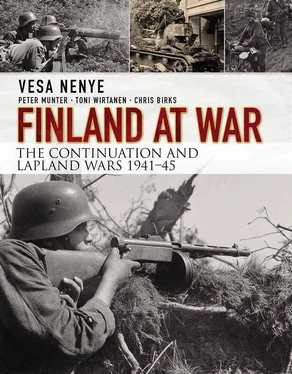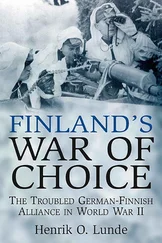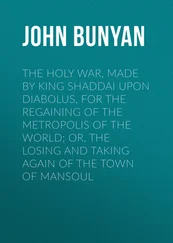1–6 October
The Finns conduct a stealth landing, starting the battle of Tornio. Over the coming days the bridgehead is heavily reinforced and all German counter-attacks repelled. The loss of Tornio accelerates the withdrawal of the whole German Twentieth Mountain Army.
2 October
German forces are ordered to destroy all industrial and military property and infrastructure in Lapland.
5 October
Soviet members of the Allied Control Commission arrive in Finland. The German high command orders General Lothar Rendulic to withdraw all his troops to Norway and take up positions at the Lyngen Fjord.
7 October
Mannerheim approaches Sweden to help with the refugee problem in the north.
8 October
Finnish troops liberate the town of Kemi.
9 October
Churchill and Stalin meet in Moscow. Finland remains outside the Soviet sphere of influence. The defeated German 7th Mountain Division escapes from Group Lagus.
13 October
German forces in Lapland are ordered to destroy all civilian property and any possible shelter the Finns could use during the oncoming winter.
16 October
Finnish forces liberate the ruined town of Rovaniemi.
19 October
The Allied Control Commission presents the Finnish government with its first list of war criminals.
20 October
The Finnish Armoured Division occupies the ruined village of Sodankylä. The Soviet Union and Yugoslavian resistance forces capture Belgrade.
23 October
Finnish troops reach the German fortifications at Tankavaara, but fail to displace German forces there.
28 October
Bulgaria makes an armistice agreement with the Allies.
30 October
Minister Tanner forbids the handing of Jewish refugees to Germany. German troops withdraw from Muonio village.
31 October
The German high command orders the troops at Tankavaara to withdraw. Following pressure from the Soviets, a law is passed in Finland disbanding all Civil Guard organisations.
1 November
The disbanding of the Finnish wartime army begins. Peacetime formations are to be in place by 5 December.
7 November
Roosevelt is re-elected for his second term as President of the United States of America.
17 November
President Mannerheim appoints the second government of Prime Minister Juho K. Paasikivi.
20 November
Finnish forces reach the border at Utsjoki.
22 November
The Soviet Union returns the first prisoners of war.
23 November
Lotta Svärd, the women’s paramilitary organisation, is disbanded.
5 December
Peacetime strength is reached in the Finnish armed forces; former soldiers have returned to civilian life. The Allied Control Commission approves Finland to take loans from the US government.
16–26 December
German forces launch the Ardennes offensive.
17 December
Agreement is reached on the amount of Finnish war reparations.
20 December
Mannerheim makes it clear to the Soviets in a letter that, going forward, Finland and the Soviet Union do not have common military goals.
27 December
Soviet forces surround Budapest.
23 January
Soviet troops reach the Polish-German border.
13 February
Soviet forces conquer Budapest.
15 February
British forces reach the old France-German border on the Rhine.
3 March
The Finnish government belatedly notes that the country has been in a state of war with Germany since 15 September 1944.
17 April
President Mannerheim appoints the third government of Prime Minister Juho Paasikivi.
18 April
German resistance in the Ruhr collapses.
20 April
Minister of the Interior Yrjö Leino hands the persons on the list drawn up by the Allied Control Commission to the Soviets.
25 April
The final shots of the Lapland War are fired in Kilpisjärvi.
27 April
Siilasvuo informs Mannerheim that all German troops have been evicted from Finnish territory, and declares the Lapland War over.
30 April
Hitler commits suicide.
8 May
Nazi Germany surrenders.
6 August
The US drops a nuclear bomb on Hiroshima.
6 August
The Soviet Union acknowledges Finland diplomatically.
9 August
The US drops a nuclear bomb on Nagasaki. The Soviet Union declares war on Japan.
10 August
Japan surrenders unconditionally.
18 August
The US recognises Finland diplomatically.
12 September
Mannerheim resigns for health reasons.
19 September
The Allied Control Commission receives recommendations that Karelia should be returned to Finnish control. The ceded lands remain in Russian hands to date.
8 October
The Soviet Union extends the deadline for Finland to pay its $300 million war reparations. The reparations will finally be repaid in full in September 1952.
15 November
The Finnish war crimes trials begin in Helsinki. Former president Risto Ryti is among those sentenced.
12 December
The US grants Finland its first national dollar loan.
Parliamentary elections end the reign of terror by the Red VALPO (secret police).
28 January
1951 Marshal of Finland, Gustav Mannerheim, dies in Lausanne, Switzerland.
CHAPTER 1
THE RETURN TO WAR
THE INTERIM PEACE: 1940–41
The 1940 truce between the Soviet Union and Finland, which concluded the conflict known as the Winter War, came at a high price for Finland. Nearly 10 per cent of the country’s total pre-war territory had to be relinquished and some 12 per cent of the population had to be evacuated from the ceded lands. According to the terms of the Moscow Peace Treaty, the Soviet Union gained control of the whole Karelian Isthmus including Finland’s second biggest city, Viipuri. Two other major towns, Käkisalmi and Sortavala, were lost, along with the part of Karelia north of Lake Ladoga. Further north, the lands east of Suojärvi, Salla and Kuusamo were similarly forfeited. On the Barents Sea, Kalastajasaarento (the Rybachy Peninsula) now belonged to the Soviet Navy, which had also demanded the leasing of Hanko harbour on the southernmost tip of Finland. The Soviet Navy’s grip on the Gulf of Finland was further tightened when strategically important Suursaari and several other large islands were handed over.
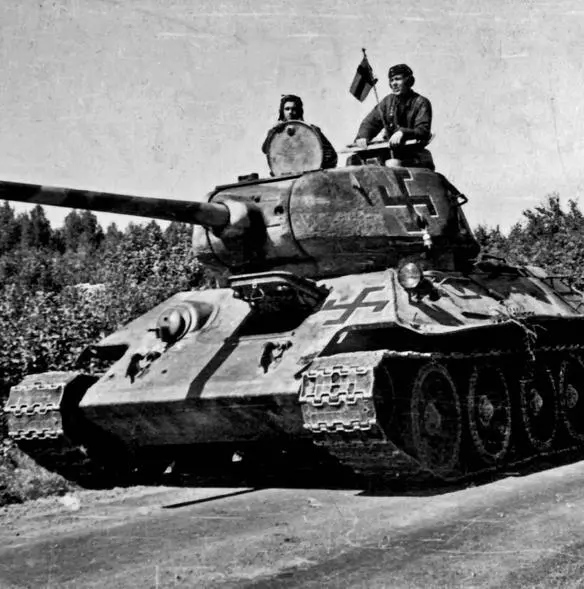
A captured T-34 Sotka tank paraded at Pihkalanjärvi. Although territory was lost, the repatriated armour remained. The large Finnish swastikas had been painted on the turret and forward armour to help identify their few own tanks. (Courtesy of the private collection of Esa Muikku)
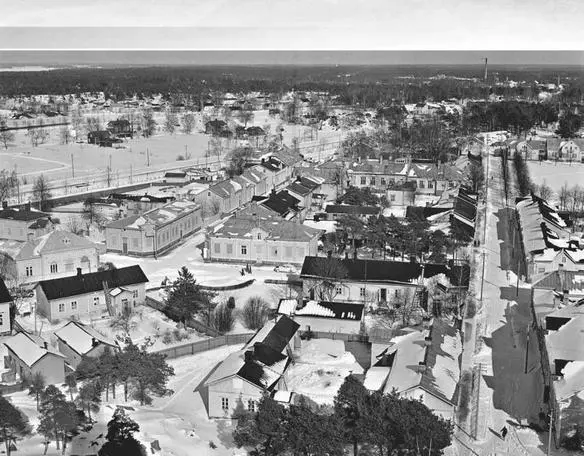
An aerial photograph of Hanko village taken a few days before the harbour was handed over to the Soviets as part of the Moscow Treaty. The village is located on the most southerly point of Finland. Gaining a foothold here considerably increased the Red Navy’s influence on the Gulf of Finland. (SA-Kuva)
The Soviets’ victory had cost them dearly; even the most conservative estimates cite over 200,000 killed with post-war Soviet leader Nikita Khrushchev claiming that the total fatalities resulting from the Winter War had exceeded one million men. The Finns buried 24,918 of their countrymen, while 9,562 of the total 43,557 wounded would remain permanently disabled.
Читать дальше
